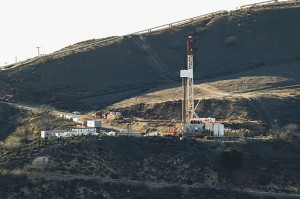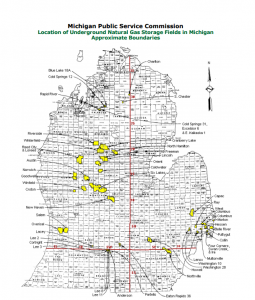California’s gas catastrophe raises questions about Michigan’s vast storage fields

Editor’s note: News of the massive natural gas leak from an underground storage reservoir near Los Angeles made us curious about the implications for Michigan. We knew there were similar storage facilities here, but we’ve learned that Michigan has more of them than any other state. While state officials say those facilities are held to strict construction and maintenance standards, the California leak raises questions about Michigan’s ability to prevent a similar incident here. As we see it, the public safety and climate risks of underground natural gas storage are further cause for Michigan’s political leaders to make a strong commitment to clean and increasingly affordable renewable energy sources.
Update: At 4:30 p.m. on Jan. 8 we added new information about the inspection of storage wells. The update clarifies that the DEQ periodically inspects storage wells.
***
As Southern California grapples with a massive natural gas leak some are comparing to the 2010 BP oil spill in the Gulf of Mexico, one expert says a similar disaster could happen in Michigan.
“The natural gas storage wells in Michigan are the same type as the one that is leaking in California, so yes, it could happen in your state too,” said Amy Townsend-Small, an assistant professor of geology at the University of Cincinnati who studies methane emissions from the gas industry.
Thousands of residents have been evacuated from the Porter Ranch neighborhood of Los Angeles after a leak was detected at an underground gas storage facility in October. Residents have complained of headaches, nausea and other health problems associated with an odorant added to the methane to make leaks more detectable. An attorney for residents says benzene and hydrogen sulfide also have been detected in air near the leak.
The leak also has become California’s biggest source of greenhouse gas emissions. About 80,000 metric tons of methane—a far more potent heat-trapping gas than carbon dioxide—has escaped into the atmosphere, according to a real-time counter from the Environmental Defense Fund.
Michigan has more underground natural gas storage capacity than any other state, according to the U.S. Energy Information Agency. Like the leaking Aliso
Canyon site, the storage facilities use depleted oil and gas fields to hold natural gas reserves.
The state’s top oil and gas official says Michigan has safeguards in place to prevent a similar disaster here.
“We’ve got some very strict, comprehensive safety standards for well construction and monitoring for gas storage in Michigan,” said Harold Fitch, chief of the Department of Environmental Quality’s Office of Oil, Gas and Minerals.
Because natural gas use rises sharply in the winter but production is relatively consistent throughout the year, gas companies use underground storage to balance supply and demand. That makes for more stable prices and more efficient use of transmission pipelines, according to the Michigan Public Service Commission.
Most storage sites are former oil and gas production wells that have been converted to hold reserves. The process involves constructing wells and injecting gas back into porous rock formations that are capped with an impermeable rock layer that prevents the gas from migrating toward the surface.
The California leak’s suspected source is a broken pipe inside the well casing used to pump gas in and out of the storage reservoir. The utility that manages the facility is working to drill a relief well more than 8,000 feet underground to the impermeable cap rock layer, where it will seal the leaking well with cement. The process could take several weeks, or even months.
Federal data show that Michigan has 43 fields that store natural gas in depleted oil and gas reservoirs—more than any other state except for Pennsylvania. However, Fitch said in an email that Michigan has 58 active storage fields, which is more than any state. There are 2,478 wells tapping into those fields, he said.
The DEQ regulates the siting of storage facilities, has stringent requirements for well construction and sets limits on pressure in the reservoirs, Fitch said.
The pipe suspected of causing the California leak is 61 years old. Some of Michigan’s gas fields were converted from production to storage as early as 1941, state data show. While some aging wells and pipes have been completely upgraded, others likely haven’t been replaced since the 1940s, said David Chislea, manager of the Michigan Public Service Commission’s Gas Operations Section.
While the companies that manage storage fields inspect those wells periodically, “there’s nothing specific that requires them to file those reports,” Chislea said. “We don’t typically see those.”
Fitch said the DEQ also inspects storage wells periodically. He noted, however, that around 20 inspectors are responsible for roughly 20,000 gas, oil, injection and storage wells, so inspections are infrequent. Those inspection reports contain “not a lot of detail, frankly,” he said.
“With what’s going on in California, we’re looking at our process ourselves, to see if there’s some improvements we can make,” Fitch said. “[Storage wells] don’t get as many inspections as an oil well or a brine injection well. But we’re looking now if we should have more complete records. We’re getting good compliance as far as what’s required, but we’re evaluating whether that’s really sufficient.”
Chislea said the Public Service Commission does not track the amount of gas stored underground at a given time, since it is regularly injected and withdrawn.
And he said an odorant is not added to natural gas in Michigan’s storage fields, and is instead typically added at distribution stations. That could make it harder to detect leaks, since natural gas is naturally colorless and odorless, said Townsend-Small.
“As far as I know, [Aliso Canyon] is an extreme example of a leak and I don’t think it’s very common,” she said. “Having said that, it might be that because this gas is odorized and the leak is occurring in a residential area, it’s more likely to be detected. If the gas in the storage fields in Michigan isn’t odorized, and the storage fields are in remote areas, it might take a while for a leak like this to be detected because natural gas is odorless and invisible.”
Asked if Michigan’s growing use of natural gas will add to the risk of leaks from storage facilities, Fitch said current trends don’t suggest increased use of storage fields.
“I’m not sure I’d predict we’ll have more storage,” he said, noting that the need for storage is driven by the seasonal fluctuation in gas use, especially for home heating in the winter. “The direction we’re taking with more and more natural gas being used in electric generation, we’re using more of it in the summer.”
However, the 2013 Managed Public Land Strategy from the Michigan Department of Natural Resources points toward increased gas storage as an economic goal. The strategy calls for increasing by 10 percent the number of acres of public land leased for mineral production and underground natural gas storage. It also recommends promoting “Michigan’s unique geology” as an asset for natural gas storage.
Townsend-Small said awareness is growing of the greenhouse-gas impacts of the gas industry. For instance, she co-authored a recent study that found methane emissions from the Barnett Shale in Texas are nearly twice as high as estimated by the U.S. Environmental Protection Agency.
“The more natural gas we use, the more leaks could occur,” she said. “More and more studies are showing that these kinds of accidental releases are the largest source of methane emissions from throughout the natural gas supply chain. Advances in leak detection and monitoring are needed to reduce these leaks.”
###
Photo of Aliso Canyon facility courtesy Scott L via Wikimedia Commons.
Browse these next
- Non Gamstop Casino
- Casino Online Migliori Italia
- Non Gamstop Casinos
- Casinos Not On Gamstop
- Casino Online Non Aams
- Non Gamstop Casino UK
- Best Non Gamstop Casinos
- Best Non Gamstop Casinos
- Online Betting Sites Not On Gamstop
- Non Gamstop Casino UK
- UK Casinos Not On Gamstop
- UK Casino Not On Gamstop
- Gambling Sites Not On Gamstop
- Casinos Not On Gamstop
- Non Gamstop Casino
- Casino En Ligne Meilleur Site
- Casino En Ligne Meilleur Site
- Casino En Ligne France
- Non Gamstop Casino Sites UK
- Top UK Casino Sites
- Best Online Casinos Uk
- Lista Casino Online Non Aams
- Casinos Not On Gamstop
- Casino Online Non Aams
- Casino Non Aams
Comments are closed.




Nailed it!
The analysis we need on the front lines.
Thank you.
I would like to know if the leaking gas storage has any traces of Radon 226 or other radioactive components therein. There is a lot of such in other parts of the nation.
You want to trust the DEQ???
You want to trust the DEQ??? NO
As we seen with the Flint Water situation state agencies are accountable to their political masters are not honest or open about what was being done. Concern for the citizens of Mi
appears to be the least thing to be concerned about in the actions of the DEQ.
Resent articles about the Flint Water situation state that shut off notices are being sent out.
I am disappointed as government is able to subsidize business for a strong economy but all citizens must pay for everything. Water is basic it should not be used as a revenue center for government nor should it be privatized and generate a profit.